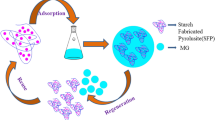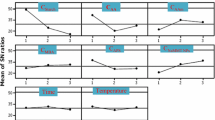Abstract
Starch based bio-nanocomposite has been introduced as a potential agent in order to upgrade the water quality. The current work describes the synthesis of bio-nanocomposite of starch and Ce (IV) sulphatoarsenate for the elimination of Trifluralin. For the analysis of synthesized material, various instrumental techniques including as TEM, SEM, FTIR, XRD and EDX were used. The SEM images shows the rough and porous surface of starch-Ce(IV) sulphatoarsenate bio-nanocomposite. Bio-nanocomposite has the potential to degrade Trifluralin (93.54%) within in 160 min. The influence of other parameters on the photodegradation of Trifluralin were also investigated such as photocatalyst dosage, pH effect and time. The ion exchange capacity of the starch-Ce(IV) sulphatoarsenate composite ion exchanger was found to be 1.77 meq/g, as compared to Ce(IV) sulphatoarsenate which was 0.35 meq/g. Starch-Ce(IV) sulphatoarsenate was found highly selective for arsenic metal ion with enhanced Kd value of 87.3 mL/g.









Similar content being viewed by others
References
Sharma A, Thakur M, Kumar A, Gautam M, Kumari S, Pathania D, Sharma A (2023) Efficient photodegradation of fast sulphon black and crystal violet dyes from water systems using locust bean gum (LBG)-encapsulated zirconium-based nanoparticles and antibacterial activity. Nanotechnol Environ Eng 8:859–877
Horrigan L, Lawrence RS, Walker P (2002) How sustainable agriculture can address the environmental and human health harms of industrial agriculture. Environ Health Perspect 110:445–456
Pedrero F, Kalavrouziotis I, Alarcón JJ, Koukoulakis P, Asano T (2010) Use of treated municipal wastewater in irrigated agriculture—review of some practices in Spain and Greece. Agri Water Manag 97:1233–1241
Khan MS, Zaidi A, Wani PA (2007) Role of phosphate solubilizing microorganisms in sustainable agriculture-a review. Agron Sustain Dev 27:29–43
Zhang C, Kovacs JM (2012) The application of small unmanned aerial systems for precision agriculture. Precis Agric 13:693–712
Eddleston M, Buckley NA, Eyer P, Dawson AH (2008) Management of acute organophosphorus pesticide poisoning. The Lancet 371:597–607
Bassil KL, Vakil C, Sanborn M, Cole DC, Kaur JS, Kerr KJ (2007) Cancer health effects of pesticides: systematic review. Can Fam Phys 53:1704–1711
Kumari A, Kumar A, Thakur M, Pathania D, Rani A, Sharma A (2023) Murraya Koenigii plant-derived biochar (BC) and lanthanum ferrite (BC/LaFeO3) nano-hybrid structure for efficient ciprofloxacin adsorption from waste water. Chem Afr 6:3079–3095
Thakur M, Sharma A, Kumar A, Gautam M, Kumari S (2023) Bio-synthesis of lead oxide nanoparticles using Chinese Mahogany plant extract (CMPE@ LO) for photocatalytic and antimicrobial activities. BioNanoScience 13:1896–1910
Barr DB, Needham LL (2002) Analytical methods for biological monitoring of exposure to pesticides: a review. J Chromatogr B Biomed Appl 778:5–29
Kumar A, Pathania D, Gupta N, Raj P, Sharma A (2020) Photo-degradation of noxious pollutants from water system using Cornulaca monacantha stem supported ZnFe2O4 magnetic bio-nanocomposite. Sustain Chem Pharm 18:100290
Thakur M, Pathania D (2019) Sol–gel synthesis of gelatin–zirconium (IV) tungstophosphate nanocomposite ion exchanger and application for the estimation of Cd (II) ions. J Sol-Gel Sci Technol 89:700–712
Pathania D, Agarwal S, Gupta VK, Thakur M, Alharbi NS (2018) Zirconium (IV) phosphate/poly (gelatin-cl-alginate) nanocomposite as ion exchanger and Al3+ potentiometric sensor. Int J Electrochem Sci Technol 13:994–1012
Pathania D, Thakur M, Jasrotia S, Agarwal S, Gupta VK (2017) Composite ion exchangers as new age photocatalyst. Int J Electrochem Sci 12:8477–8494
Kumar A, Sharma G, Thakur M, Pathania D (2019) Sol–gel synthesis of polyacrylamide-stannic arsenate nanocomposite ion exchanger: binary separations and enhanced photocatalytic activity. SN Appl Sci 1:862
Kaur K, **dal R (2018) Synergistic effect of organic-inorganic hybrid nanocomposite ion exchanger on photocatalytic degradation of Rhodamine-B dye and heavy metal ion removal from industrial effluents. J Environ Chem Eng 6:7091–7101
Boussahel R, Bouland S, Moussaoui KM, Montiel A (2000) Removal of pesticide residues in water using the nanofiltration process. Desalination 132:205–209
Guillard C, Disdier J, Monnet C, Dussaud J, Malato S, Blanco J, Maldonado MI, Herrmann JM (2003) Solar efficiency of a new deposited titania photocatalyst: chlorophenol, pesticide and dye removal applications. Appl Catal 46:319–332
Kumar A, Chandel M, Thakur M (2021) Structural modifications of carbon nitride for photocatalytic applications. Photocatal Adv Eng Mater 100:299–331
Kumar A, Sharma SK, Kumar A, Sharma G, AlMasoud N, Alomar TS, Naushad M, ALOthman ZA, Stadler FJ (2021) High interfacial charge carrier separation in Fe3O4 modified SrTiO3/Bi4O5I2 robust magnetic nano-heterojunction for rapid photodegradation of diclofenac under simulated solar-light. J Clean Prod 315:128137
Pathania D, Sharma A, Kumar S, Srivastava AK, Kumar A, Singh L (2021) Bio-synthesized Cu–ZnO hetro-nanostructure for catalytic degradation of organophosphate chlorpyrifos under solar illumination. Chemosphere 277:130315
Kumar A, Chandel M, Sharma A, Thakur M, Kumar A, Pathania D, Singh L (2021) Robust visible light active PANI/LaFeO3/CoFe2O4 ternary heterojunction for the photo-degradation and mineralization of pharmaceutical effluent: Clozapine. J Environ Chem Eng 9:106159
Hachem C, Bocquillon F, Zahraa O, Bouchy M (2001) Decolourization of textile industry wastewater by the photocatalytic degradation process. Dyes Pigm 49:11–25
Bedos C, Rousseau-Djabri MF, Flura D, Masson S, Barriuso E, Cellier P (2002) Rate of pesticide volatilization from soil: an experimental approach with a wind tunnel system applied to trifluralin. Atmos Environ 36:5917–5925
Sadeghi F, Fadaei A, Mohammadi-Moghadam F, Hemati S, Mardani G (2021) Photocatalytic degradation of trifluralin in aqueous solutions by UV/S2O82and UV/ZnO processes: a comparison of removal efficiency and cost estimation. Int J Chem Eng 2021:1–10
Tor JM, Xu C, Stucki JM, Wander MM, Sims GK (2000) Trifluralin degradation under microbiologically induced nitrate and Fe (III) reducing conditions. Environ Sci Technol 34:3148–3152
Kajitvichyanukul P, Nguyen VH, Boonupara T, Thi LAP, Watcharenwong A, Sumitsawan S, Udomkun P (2022) Challenges and effectiveness of nanotechnology-based photocatalysis for pesticides-contaminated water: a review. Environ Res 212:113336
Fernandes TC, Mazzeo DE, Marin-Morales MA (2007) Radioprotective and cytoprotective activity of Tinospora cordifolia stem enriched extract containing cordifolioside. Pestic Biochem Physiol 88:252–259
Mir NA, Khan A, Muneer M, Vijayalakhsmi S (2014) Photocatalytic degradation of trifluralin, clodinafop-propargyl, and 1,2-dichloro-4-nitrobenzene as determined by gas chromatography coupled with mass spectrometry. Chromatogr Res Int 2014:261683
Ebrahimpour M, Hassaninejad-Darzi SK, Mousavi HZ, Samadi-Maybodi A (2022) Simultaneous monitoring of the photocatalytic degradation process of trifluralin and pendimethalin herbicides by SBA-15/TiO2 nanocomposite. Environ Nanotechnol Monit Manag 18:100678
Bagal MV, Nandgawle BA, Thosar RV, Mohod AV, Gogate PR (2023) Degradation of pesticides using hybrid processes based on cavitation and photocatalysis: a review. Environ Qual Manag. https://doi.org/10.1002/tqem.22097
Vaya D, Surolia PK (2020) Semiconductor based photocatalytic degradation of pesticides: An overview. Environl Technol Innov 20:101128
Ali A, **e F, Yu L, Liu H, Meng L, Khalid S, Chen L (2018) Preparation and characterization of starch-based composite films reinfoced by polysaccharide-based crystals. Compos Part B-Eng 133:1122–1128
Qiu C, Wang C, Gong C, McClements DJ, ** Z, Wang J (2020) Advances in research on preparation, characterization, interaction with proteins, digestion and delivery systems of starch-based nanoparticles. Int J Biol Macromol 152:117–125
Pathania D, Sharma G, Thakur R (2015) Composite ion exchangers as new age photocatalyst. ChemEng J 267:235–244
Thakur M, Sharma G, Ahamad T, Ghfar AA, Pathania D, Naushad M (2017) Efficient photocatalytic degradation of toxic dyes from aqueous environment using gelatin-Zr (IV) phosphate nanocomposite and its antimicrobial activity. Colloid Surface B 157:456–463
Raizada P, Singh P, Kumar A, Sharma G, Pare B, Jonnalagadda SB, Thakur (2014) Polar photocatalytic activity of nano-ZnO supported on activated carbon or brick grain particles: role of adsorption in dye degradation. Appl Catal A-Gen 486:159–169
Jimmy CY, Yu J, Zhang L, Ho W (2002) Enhancing effects of water content and ultrasonic irradiation on the photocatalytic activity of nano-sized TiO2 powders. J Photochem Photobiol A 148:263–271
Habib IY, Kumara NT, Lim CM, Mahadi AH (2018) Dynamic light scattering and zeta potential studies of ceria nanoparticles. Solid State Phenom 278:112–120
Zhang Z, Sun J, Li C, Marhaba TF, Zhang W, Zhang Y (2016) Arsenic speciation by sequential extraction from As-Fe precipitates formed under different coagulation conditions. Water Air Soil Pollut 227:309
Pathania D, Thakur M, Puri V, Jasrotia S (2018) Composite ion exchangers as new age photocatalyst. Adv Powder Technol 29:915–924
Pathania D, Thakur M, Sharma G, Mishra AK (2018) Tin (IV) phosphate/poly (gelatin-cl-alginate) nanocomposite: Photocatalysis and fabrication of potentiometric sensor forPb (II). Today Commun 14:282–293
Pathania D, Gupta D, Ala’a H, Sharma G, Kumar A, Naushad M, Ahamad T, Alshehri SM (2016) Photocatalytic degradation of highly toxic dyes using chitosan-g-poly (acrylamide)/ZnS in presence of solar irradiation. J Photochem Photobiol A 329:61–68
Kant S, Pathania D, Singh P, Dhiman P, Kumar A (2014) Removal of malachite green and methylene blue by Fe0. 01Ni0. 01Zn0. 98O/polyacrylamide nanocomposite using coupled adsorption and photocatalysis. Appl Catal 147:340–352
Pathania D, Sharma G, Kumar A, Kothiyal NC (2014) Fabrication of nanocomposite polyaniline zirconium (IV) silicophosphate for photocatalytic and antimicrobial activity. J Alloy Compd 588:668–675
Hasanzadeh A, Khataee A, Zarei M, Joo SW (2018) Photo-assisted electrochemical abatement of trifluralin using a cathode containing a C60-carbon nanotubes composite. Chemosphere 199:510–523
Ebrahimpour M, Hassaninejad-Darzi SK, Mousavi HZ, Samadi-Maybodi A (2022) Simultaneous monitoring of the photocatalytic degradation process of 2) trifluralin and pendimethalin herbicides by SBA-15/TiO2 nanocomposite. Environ Nanotechnol Monit Manag 18:100678
Hosseini N, Toosi MR (2019) Removal of 2, 4-D, glyphosate, trifluralin, and butachlor herbicides from water by polysulfone membranes mixed by graphene oxide/TiO2 nanocomposite: Study of filtration and batch adsorption. J Environ Health Sci Eng 17:247–258
Kumar A, Chandel M, Sharma A, Thakur M, Kumar A, Pathania D, Singh L (2021) visible light active PANI/LaFeO3/CoFe2O4 ternary heterojunction for the photo-degradation and mineralization of pharmaceutical effluent: Clozapine. J Environ Chem Eng 9:106159
Author information
Authors and Affiliations
Corresponding author
Ethics declarations
Conflict of Interest
Authors declare no conflict of interest among this research work.
Consent to Publish
Informed consent was obtained from all Authors included in this research work.
Supplementary Information
Below is the link to the electronic supplementary material.
Rights and permissions
Springer Nature or its licensor (e.g. a society or other partner) holds exclusive rights to this article under a publishing agreement with the author(s) or other rightsholder(s); author self-archiving of the accepted manuscript version of this article is solely governed by the terms of such publishing agreement and applicable law.
About this article
Cite this article
Thakur, M., Kumar, A., Sharma, A. et al. Synthesis of Potato-Starch Based Bio-nanocomposite for the Removal of Trifluralin Under Visible Light Illumination. Chemistry Africa 7, 1981–1993 (2024). https://doi.org/10.1007/s42250-024-00888-4
Received:
Accepted:
Published:
Issue Date:
DOI: https://doi.org/10.1007/s42250-024-00888-4




